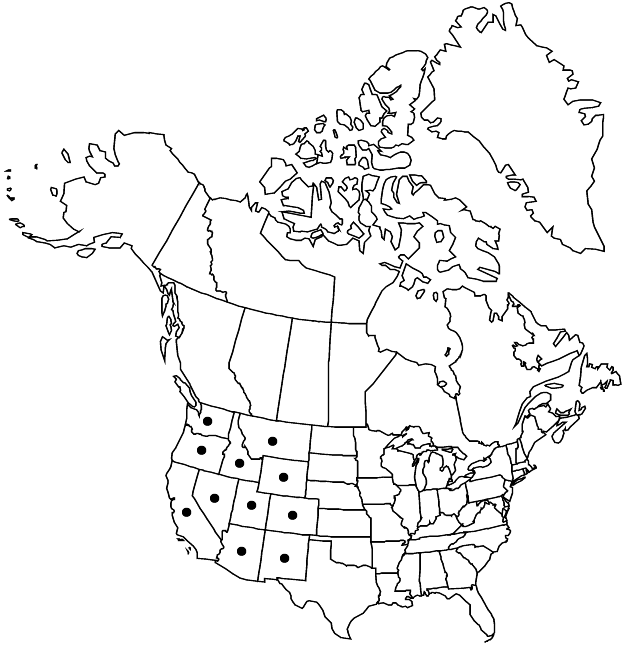Eriogonum microthecum
Proc. Acad. Nat. Sci. Philadelphia 4: 15. 1848.
Subshrubs or shrubs, erect to spreading, not scapose, 0.2–1.5 × (0.6–)1–13(–16) dm, white- to tannish-tomentose, floccose, or glabrous. Stems spreading to erect, typically without persistent leaf bases, up to 1/2 height of plant; caudex stems absent or spreading; aerial flowering stems erect to spreading, slender, solid, not fistulose, 0.05–1.5 dm, lanate, tomentose, floccose, subglabrous, or glabrous. Leaves cauline, 1 per node or fasciculate; petiole 0.1–0.5 cm, tomentose to floccose or glabrous; blade usually elliptic, sometimes linear to obovate, 0.3–3.5 × (0.07–)0.1–1.2 cm, tomentose abaxially, less so or glabrous adaxially, margins occasionally revolute. Inflorescences cymose, compact, often flat-topped, 0.5–6(–12) × 1–10(–13) cm; branches dichotomous, whitish-lanate to brownish- or reddish-tomentose to floccose or glabrate, infrequently green or gray and subglabrous or glabrous; bracts 3, scalelike, linear to triangular, 1–5 mm. Peduncles absent or mostly erect, slender, 0.3–1.5 cm, tomentose to floccose. Involucres 1 per node, turbinate, (1.5–)2–3.5(–4) × 1.3–2.5(–3) mm, tomentose, floccose, subglabrous, or glabrous; teeth 5, erect, (0.3–)0.5–1(–1.7) mm. Flowers 1.5–3(–4) mm; perianth yellow or white to pink, orange, rose, red, or occasionally cream, glabrous; tepals connate proximal 1/5–2/5, essentially monomorphic, oblong to obovate; stamens usually exserted, 2.5–4 mm; filaments sparsely to densely puberulent proximally. Achenes brown, 1.5–3 mm, glabrous.
Distribution

w United States.
Discussion
Varieties 13 (13 in the flora).
Eriogonum microthecum is used as browse by deer and to a lesser degree by cattle and sheep. Some forms are now in cultivation. The species is reportedly used by the Piute of Nevada in the treatment of tuberculosis, lameness, rheumatism, and bladder trouble (P. Train et al. 1941). S. A. Weber and P. D. Seaman (1985) stated that A. F. Whiting found the plants being used as a tea by the Havasupai in northern Arizona. Members of E. microthecum are food plants for subspecies of the rare pallid blue butterfly (Euphilotes pallescens). Also found on this species is the cythera metalmark (Apodemia mormo cythera). Some authors have referred E. effusum to this species, even though the ranges of the two species do not overlap and intermediates are unknown.
Selected References
None.
Lower Taxa
Key
| 1 | Perianths yellow | > 2 |
| 1 | Perianths various shades of white, cream, orange, pink, or red, not yellow | > 4 |
| 2 | Flowering stems and inflorescence branches usually glabrous; e Oregon and wc Idaho | Eriogonum microthecum var. microthecum |
| 2 | Flowering stems and inflorescence branches tomentose to floccose; se Oregon and sw Idaho s to e California and w Nevada | > 3 |
| 3 | Leaf blades (0.2-)0.3-0.6(-0.8) cm wide; flowers (1.5-)2-2.5(-3) mm; involucres 2-2.5 mm; achenes 1.5-2 mm; se Oregon and sw Idaho s to e California and w Nevada | Eriogonum microthecum var. ambiguum |
| 3 | Leaf blades 0.5-1.2 cm wide; flowers 2.5-3 mm; involucres 2.5-4 mm; achenes 2.5-3 mm; ne California, nw Nevada | Eriogonum microthecum var. schoolcraftii |
| 4 | Tomentum whitish (see also var. alpinum of the Sierra Nevada, California); flowering stems and inflorescence branches infrequently glabrous | > 5 |
| 4 | Tomentum brownish or reddish (may be white in var. alpinum), or flowering stems and inflorescence branches essentially glabrous | > 6 |
| 5 | Leaf margins not revolute; flowering inflorescence branches floccose or glabrous; northern phase of species | Eriogonum microthecum var. laxiflorum |
| 5 | Leaf margins revolute or nearly so; flowering inflorescence branches lanate to tomentose, or if subglabrous or glabrous, then southern phase of species | Eriogonum microthecum var. simpsonii |
| 6 | Plants shrubs, 3-6 dm | > 7 |
| 6 | Plants subshrubs, 0.2-1.5(-2) dm | > 8 |
| 7 | Flowering stems and inflorescence branches tomentose when young, becoming floccose at maturity; flowers 1.5-2(-2.5) mm; achenes 1.8-2 mm; Death Valley region, California | Eriogonum microthecum var. panamintense |
| 7 | Flowering stems and inflorescence branches lanate to tomentose at maturity; flowers 2-2.5(-3) mm; achenes 2.5-3 mm; Transverse Ranges, California | Eriogonum microthecumvar. corymbosoides |
| 8 | Leaf blades elliptic or ovate, margins not revolute; flowers (1.5-)2-3.5(-4) mm | > 9 |
| 8 | Leaf blades linear or linear-oblanceolate to narrowly elliptic, margins often revolute; flowers 1.5-2.5 mm | > 10 |
| 9 | Leaf blades 0.5-1 × (0.2-)0.3-0.5(-0.6) cm; involucres (2-)2.5-3 mm; flowers (2.5-)3-3.5(-4) mm; San Gabriel Mountains, California | Eriogonum microthecum var. johnstonii |
| 9 | Leaf blades 0.3-0.7(-0.8) × 0.1-0.4 cm; involucres 2.5-3.5 mm; flowers (1.5-)2-3.5 mm; desert ranges of se California, c Nevada, and Utah1f. Eriogonum microthecum var. lapidicola [8. Shifted to left margin—Ed.] | > 8 |
| 10 | Involucres 3-4 mm; perianths cream; San Bernardino Mountains, California | Eriogonum microthecum var. lacus-ursi |
| 10 | Involucres (1.5-)2-3 mm; perianths white, pink, red, or rose; Sierra Nevada of California, or e Nevada and w Utah | > 11 |
| 11 | Flowering stems glabrous; leaf blades sparsely floccose or glabrous adaxially; desert ranges, se Nevada | Eriogonum microthecum var. arceuthinum |
| 11 | Flowering stems white- to brownish-floccose to subglabrous, or reddish-tomentose to floccose; leaf blades floccose to subglabrous adaxially; California or wc Utah | > 12 |
| 12 | Tomentum white to brownish; Sierra Nevada, California | Eriogonum microthecum var. alpinum |
| 12 | Tomentum reddish; desert ranges, wc Utah | Eriogonum microthecum var. phoeniceum |